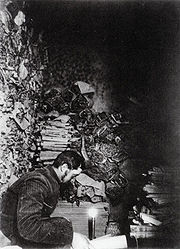
Old Tibetan Chronicle
Encyclopedia

Tibetan language
The Tibetan languages are a cluster of mutually-unintelligible Tibeto-Burman languages spoken primarily by Tibetan peoples who live across a wide area of eastern Central Asia bordering the Indian subcontinent, including the Tibetan Plateau and the northern Indian subcontinent in Baltistan, Ladakh,...
language, including the famous (Old) Tibetan Annals
Tibetan Annals
The Tibetan Annals, or Old Tibetan Annals , are composed of two manuscripts written in Old Tibetan language found in the early 20th century in the "hidden library", the Mogao Grottoes near Dunhuang, which is believed to have been sealed in the 11th century CE...
, found in the early 20th century in the so-called "hidden library", the Mogao Grottoes near Dunhuang
Dunhuang
Dunhuang is a city in northwestern Gansu province, Western China. It was a major stop on the ancient Silk Road. It was also known at times as Shāzhōu , or 'City of Sands', a name still used today...
, which is believed to have been sealed in the 11th century CE. They form Tibet's earliest extant history.
Discovery
An enormous number of early manuscripts in a variety of languages were collected by Aurel Stein and Paul PelliotPaul Pelliot
Paul Pelliot was a French sinologist and explorer of Central Asia. Initially intending to enter the foreign service, Pelliot took up the study of Chinese and became a pupil of Sylvain Lévi and Édouard Chavannes....
at the famous sealed-up Library Cave (no. 17) of the Mogao Grottoes and sent back to London and Paris respectively. Among these Dunhuang manuscripts
Dunhuang manuscripts
The Dunhuang manuscripts is a cache of important religious and secular documents discovered in the Mogao Caves of Dunhuang, China during the early 20th century. Dating from the 5th to early 11th centuries, the manuscripts include works ranging from history and mathematics to folk songs and dance...
, were found along with the "Old Tibetan Chronicle", which was probably compiled between 800-840 CE. and The Tibetan Annals (or "Tibet’s First History").
The manuscript containing the Chronicle is in the Paul Pelliot
Paul Pelliot
Paul Pelliot was a French sinologist and explorer of Central Asia. Initially intending to enter the foreign service, Pelliot took up the study of Chinese and became a pupil of Sylvain Lévi and Édouard Chavannes....
Collection at the Bibliothèque Nationale in Paris. It is made up of two different strips of paper with a total length of 6.2 metres (20.3 feet). The first strip of thin paper contains the first six chapters that Pelliot and his team made of the text. The second strip, made of strong paper, contains the other four chapters.
Contents
The Chronicle, largely fictitious, begins with the reign of King Drigum TsenpoDrigum Tsenpo
Drigum Tsenpo was an emperor of Tibet. According to Tibetan mythology, he was the first king of Tibet to lose his immortality when he angered his stable master, Lo-ngam. Legend states that rulers of Tibet descended from heaven to earth on a cord, and that they were pulled back up when their time...
, the seventh king in the genealogy given in Ms. 249, (and, although originally coming from the sky, like the previous kings, he was the first to be buried on earth). The Chronicle then continues up to and including the reign of king Tridu Songtsen (670–704; r. 676–704 CE
Common Era
Common Era ,abbreviated as CE, is an alternative designation for the calendar era originally introduced by Dionysius Exiguus in the 6th century, traditionally identified with Anno Domini .Dates before the year 1 CE are indicated by the usage of BCE, short for Before the Common Era Common Era...
). The account of the latter king is confused as it contains material clearly from the reign of Songstan Gampo.
The Chronicle plainly attests to a well-organized feudal society with an established hierarchy and rites in Tibet from the middle of the 6th century CE. The boldness and skill of the policies of the emperors of the 7th and 8th centuries are plain to see.
For some reason the important conquest of the Chinese Four Garrisons of Anxi
Four Garrisons of Anxi
The Four Garrisons of Anxi were Chinese military garrisons installed by Tang Dynasty between 648 and 658 that stationed at the city and capital of the Indo-European statelet Kucha, Khotan, Kashgar and Karashahr, the capital of Kucha was also the seat of Protectorate General to Pacify the West...
in 670 is not mentioned and neither is the emperor Mangsong Mangtsen
Mangsong Mangtsen
Mangsong Mangtsen, Trimang Löntsen or Khri-mang-slon-rtsan succeeded to the throne after the death of his grandfather, Songtsän Gampo, and was the second emperor of the newly created Tibetan Empire....
(650-676) under whom these conquests were made.
Neither the Annals nor the Chronicle make any mention of Buddhism in the reign of Songtsan Gampo. However, the Chronicle does say that, during the reign of king Khri srong lde brtsan (Trisong Detsen) (r. 755-ca.797 AD.), "The incomparable religion of the Buddha had been received and there were vihara
Vihara
Vihara is the Sanskrit and Pali term for a Buddhist monastery. It originally meant "a secluded place in which to walk", and referred to "dwellings" or "refuges" used by wandering monks during the rainy season....
s (monasteries) in the centre as well as the borderlands of the country."

